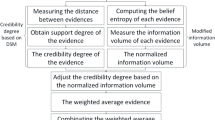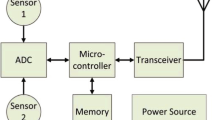Abstract
In wireless sensor network-based event detection approaches, when the decision is taken based on the measurements of sensors, sensor-fault and noise-related measurement error should be taken into account. Using Bayesian approach to form a judgment is problematic without additional information or assumptions (for example, the difficulty of knowing prior probabilities in practice). In making the final decision using the majority decision rule (as well as the k-out-of-n rule), measurement of every sensor is considered as fully reliable. However, due to sensor fault and environmental noise, the preciseness of all measurements may not be guaranteed in real-life applications. This paper presents a Dempster–Shafer theory of evidence-based structural health monitoring protocol using wireless sensor networks that overcome these limitations. Our proposal effectively discounts the unreliable observer’s (sensor’s) measurements. Extensive simulations show significant improvement in terms of detection accuracy as compared to other well-known approaches.



Similar content being viewed by others
References
Chang F-K (2001) Structural health monitoring: The demands and challenges. CRC, New York
Lynch JP, Sundararajan A, Law KH, Kiremidjian AS, Carryer E (2003) Power-efficient data management for a wireless structural monitoring system. Proc. of the 4th International Workshop on Structural Health Monitoring, pp. 15–17
Xu N et al (2004) A wireless sensor network for structural monitoring. Proc. of SENSYS. ACM, pp. 13–24
Mechitov K, Kim W, Agha G, Nagayama T (2004) High-frequency distributed sensing for structure monitoring. Proc. of First Intl. Workshop on Networked Sensing Systems (INSS)
Hamid MA, Wadud MA, Alam MM (2011) A reliable structural health monitoring protocol using wireless sensor networks. In: Proc. of the 14th International Conference on Computer and Information Technology (ICCIT 2011), December 2011, Dhaka, vol. 13, issue 6, pp. 601–606
Lynch JP, Sundararajan A, Law KH, Kiremidjian AS, Carryer E, Sohn H, Farrar C. R (2003) Field validation of a wireless structural monitoring system on the Alamosa Canyon Bridge. Proc. of SPIE’s 10th Annual International Symposium on Smart Structures and Materials, San Diego, March 2–6, 2003.
Mascareñas D, Flynn E, Farrar C, Park G, Todd M (2009) A mobile host approach for wireless powering and interrogation of structural health monitoring sensor networks. IEEE Sensors J 9(12):1719–1726
Benini L, Brunelli D, Petrioli C, Silvestri S (2010) GENESI: Green sEnsor NEtworks for Structural monItoring. 7th Annual IEEE Communications Society Conference on Sensor Mesh and Ad Hoc Communications and Networks SECON 2010, pp. 10–12
Ling Q, Tian Z, Yin Y, Li Y (2009) Localized structural health monitoring using energy-efficient wireless sensor networks. IEEE Sensors J 9(11):1596–1604
Chin J, Rautenberg JM, Ma CYT, Pujol S, Yau DKY (2009) An experimental low-cost, low-data-rate rapid structural assessment network. IEEE Sensors J 9(11):1361–1369
Lédeczi Á, Hay T, Völgyesi P, Hay DR, Nádas A, Jayaraman S (2009) Wireless acoustic emission sensor network for structural monitoring. IEEE Sensors J 9(11):1370–1377
Krishnamachari B, Iyengar S (2004) Distributed Bayesian algorithms for fault-tolerant event region detection in wireless sensor networks. IEEE Trans Comput 53:241–250
Koller D, Friedman N (2009) Probabilistic graphical models—principles and techniques. MIT, Cambridge
Luo X, Member S, Dong M, Huang Y (2006) On distributed fault-tolerant detection in wireless sensor networks. IEEE Trans Comput 55(1):58–70
Salicone S (2006) Measurement uncertainty: An approach via the mathematical theory of evidence. Springer, Berlin
Varshney PK (1996) Distributed detection and data fusion. Springer-Verlag, New York
Guan JW, Bell DA (1991) Evidence theory and its applications. North-Holland, New York
Osswald C, Martin A (2008) Discrete labels and rich foci in theory of evidence. International Conference on Information Fusion, pp. 1426–1423
Cobb BR, Shenoy PP (2006) On the plausibility transformation method for translating belief function models to probability models. Int J Approx Reason 41(3):314–330
Denoeux T (1997) Analysis of evidence—theoretic decision rules for pattern classification. Pattern Recog 30(7):095–1107
Smets P (1990) The combination of evidence in the transferable belief model. IEEE Trans Pattern Anal Mach Intell 12:447–458
Smets P (2005) Decision making in the TBM: the necessity of the pignistic transformation. Int J Approx Reason 38:133–147
Denoeux T (2000) A neural network classifier based on Dempster–Shafer theory. IEEE Trans Syst Man Cybern 30(2):131–150
Boston JR (2000) A signal detection system based on Dempster–Shafer theory and comparison to fuzzy detection. IEEE Transactions on Systems, Man, and Cybernetics, vol. 30, pp. 45–51
Acknowledgments
This work was supported by the Hankuk University of Foreign Studies Research Fund of 2012.
Author information
Authors and Affiliations
Corresponding author
Rights and permissions
About this article
Cite this article
Abdullah-Al-Wadud, M., Hamid, M.A. A fault-tolerant structural health monitoring protocol using wireless sensor networks. Ann. Telecommun. 69, 219–228 (2014). https://doi.org/10.1007/s12243-012-0336-5
Received:
Accepted:
Published:
Issue Date:
DOI: https://doi.org/10.1007/s12243-012-0336-5




